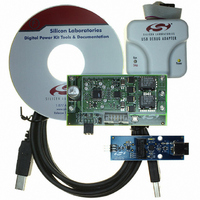MULTIPHSPOL-RD Silicon Laboratories Inc, MULTIPHSPOL-RD Datasheet - Page 14

MULTIPHSPOL-RD
Manufacturer Part Number
MULTIPHSPOL-RD
Description
KIT REFERENCE DESIGN FOR SI825X
Manufacturer
Silicon Laboratories Inc
Type
Other Power Managementr
Specifications of MULTIPHSPOL-RD
Main Purpose
DC/DC, Step Down
Outputs And Type
1, Non-Isolated
Voltage - Output
3.3V
Current - Output
40A
Voltage - Input
10 ~ 15V
Regulator Topology
Buck
Frequency - Switching
391kHz
Board Type
Fully Populated
Utilized Ic / Part
SI8250, SI8251, SI8252
Input Voltage
10 V to 15 V
Output Voltage
3.3 V
Interface Type
USB
Product
Power Management Modules
Supply Current
10 A
For Use With/related Products
Si8250
Lead Free Status / RoHS Status
Contains lead / RoHS non-compliant
Power - Output
-
Lead Free Status / Rohs Status
Lead free / RoHS Compliant
Other names
336-1323
Si8250/1/2
2. Benefits of Digital Power Control
Digitally-controlled power systems have the following
key advantages over analog implementations:
14
In-system programmability: Virtually all aspects of
digital controller behavior can be changed in
software locally or remotely and without hardware
modification. This benefits the system in several
ways:
More advanced control algorithms: Power supply
design with fixed-function analog components leads
to many performance trade-offs. For example,
analog compensator design routinely trades stability
for higher loop bandwidth and places the required
poles and zeros using passive components. The "if-
then-else" decision-making capability of digital
control can change loop bandwidth as needed for
optimum control response. For example, the
controller can operate the compensator at a
relatively low bandwidth during steady-state
operation, but significantly extend bandwidth during
a transient. This adaptive response concept can be
applied to improve other operating parameters, such
as efficiency.
Power Efficiency Optimization: In a switched mode
power supply, it is desirable to maintain high power
efficiency over a wide range of loads. Software
algorithms can optimize efficiency at every point of
line and load. For example, the software can adjust
dead time with changing load, disable synchronous
rectification at low loads, or take other measures to
maximize efficiency.
Hardware designs can be segregated into base
platforms (for example, by form factor or output power),
and optimized to the end application in software. This
lowers development costs by reducing the total number
of hardware designs required to address a given
application segment.
The controller's ability to readily accept changes
enables low-cost, custom power supply versions with
relatively short lead-times.
The cost and risk of field configuration and/or updating
is greatly reduced, lowering the overhead associated
with customer support.
Rev. 1.0
Higher operating precision: Switch timing, control
response, and protection setting thresholds in
analog systems are typically determined by the
values of external passive components. These
components typically have a wide tolerance and vary
with temperature and time. Designers must allow for
these tolerances when considering worst-case
operating conditions. Digital control offers tighter
parameter tolerances with greatly reduced
temperature/time variations, resulting in improved
worst-case operating specifications.
Power management and power delivery functions in
a single package: Power management functions,
such as external supply sequencing and fan control
can be performed by the digital controller, eliminating
dedicated external components.
System connectivity: Communication protocols
enable system processors to communicate with the
power supply to obtain data and command action.
For example, the system processor may request the
power supply operating history, perform self-
diagnostics, or change system settings without
taking the supply off-line. Communication with the
system controller enables notification of a pending
power supply failure, enhancing system reliability.
This attribute also reduces the cost and complexity
of field configurations and upgrades.
Higher integration/smaller size/lower cost: Many
discrete circuits can be transformed to lines of
software code, eliminating components and lowering
cost. The digital controller can be used to execute
self-diagnostic routines during production test,
thereby reducing test time and lowering cost. The
small physical size of the Si8250 in particular
(5 x 5 mm) saves board space.










